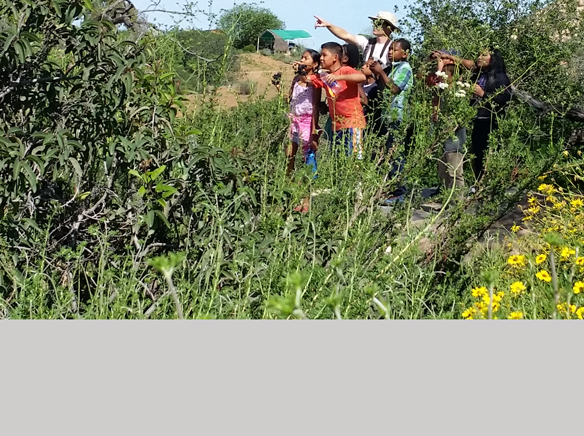There is a saying that if you are interested in results in a year — grow plants. If you want results over a decade, grow trees. If you want results over a century, then educate children.
This and more is exactly what the San Diego Foundation will do in the East County and Alpine regions by funding local nonprofit organizations.
There is a saying that if you are interested in results in a year — grow plants. If you want results over a decade, grow trees. If you want results over a century, then educate children.
This and more is exactly what the San Diego Foundation will do in the East County and Alpine regions by funding local nonprofit organizations.
Elementary and middle school students will get to experience the outdoors through the Opening the Outdoors Funds Project, which announced $400,300 in grants for 10 local programs, including two in East County, the Crestridge Ecological Reserve/Conserved Open Space Engagement and Expansion and the Living Classroom Program. The foundation received 30 different proposals but this year required that the organizations apply as partnerships.
Nicola Hedge, director of Environmental Initiatives at the San Diego Foundation, said the foundation wanted to find partnerships that would protect and engage the youth in their communities to make sure San Diego has natural amenities and access to a clean and healthy environment for future generations.
The foundation commissioned a report called Parks for Everyone, which found that while 45 percent of the community is open space, there is disparity in lower income, ethnically diverse neighborhoods in their access to natural areas.
“These two projects are great examples of how nonprofits are using their track record in this space, engaging youths through East County and the back country to get youths outdoors to those special places that we have, Crestridge Ecological Reserve and other parts around Alpine, and engage them in environmental education as well as habitat restoration projects and really soak their pride as the next generation of environmental stewards,” Hedge said.
Overall 27 organizations will help more than 5,000 youths from areas with limited to no park access and low-income communities to experience the outdoors. These efforts will run in line with the school year.
The first program, Crestridge Ecological Reserve/Conserved Open Space Engagement and Expansion, is a partnership between the Endangered Habitats Conservancy and the Earth Discovery Institute. The program will engage more than 1,000 students in the Cajon Valley Union School District and one or two other districts in environmental education, habitat restoration and open space activities using a $50,957 grant.
Scott Grimes, vice president of the Endangered Habitats Conservancy, said the students would enjoy their new classroom, the ecological reserve.
“With the Earth Discovery Institute’s work, our hope is that the students and families who come to the reserve first and foremost use it as an opportunity to learn about science,” Grimes said. “The second part of it is we want them to become enthusiastic enjoyers of nature … that they would maybe come to the reserve for the first time, have a really positive experience and then want to come back,” said Grimes.
Cathy Chadwick, director of the Earth Discovery Institute, said student enjoyment and involvement in the natural world could help them develop a great responsibility over it. It’s also good for their physical and mental health.
“When, as adults, you’re called on to make decisions as a voter, as a leader, as a person in business, about the impact of decisions you make, we from the environmental community think it’s really important people take the natural world into consideration,” she said.
The second program, the Living Classroom Program, will provide 500 students in East County with nature curriculum and hands-on service learning projects through the Back Country Land Trust and the Alpine Education Foundation.
This $20,000 grant will filter out to about $40 per student for logistics and a portion to developing next generation science standards. The selection process for schools will be first-come, first-served after the curriculum is created and will include surrounding districts like the Mountain Empire Unified School District among others.
Jon Green, program and outreach director for Back Country Land Trust, said the trust owns and protects 4,000 acres of East County land for wildlife, habitat and outdoor recreation use. They plan to use Wright Field, but may expand into other areas in the back country of Mountain Empire.
While there are environmental and societal benefits to the program, he said people should not be quick to dismiss the economic benefits to San Diego, both the lower income communities and the county as a whole. It’s also important for the Mountain Empire Unified School District, the lowest-ranked school district in the county.
“These communities do not have much economy, there’s not a lot of money moving around, so every dollar that we can bring to the East County, especially around children and education, teachers and schools, is really an essential program out here,” Green said. “We got to stimulate our economy and get our communities to be healthier. And when they’re healthy and affluent, then they’re able to protect the environment more.”
Jessica Manning, vice president of the Alpine Education Foundation, said it was easy to get in touch with districts in Alpine because of the pre-established relationships with Mountain Empire School District and the superintendent. She hopes to continue that communication for the curriculum.
“It’s a little bit easier to go and teach students about the environment on a slideshow presentation in the classroom but it’s just so much of a more comprehensive experience if they can actually be out touching the things, seeing the plants and knowing what endangered species mean …and speaking with geologists about the land that works in that field,” Manning said. “That is something we can give those students so they might have a desire to go on and study in their future and maybe they wouldn’t have found out about until they were much older or maybe ever, if they weren’t exposed to that.”














